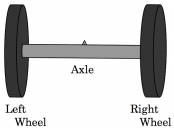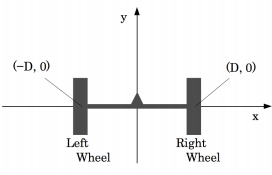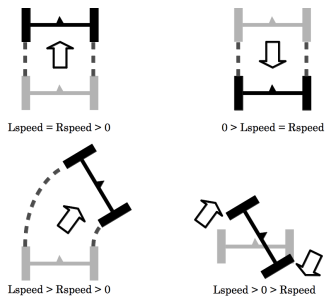1499 . Two-Wheel Buggy
Description
International Car Production Company (ICPC), one of the largest automobile manufacturers in
the world, is now developing a new vehicle called “Two-Wheel Buggy”. As its name suggests,
the vehicle has only two wheels. Quite simply, “Two-Wheel Buggy” is made up of two wheels
(the left wheel and the right wheel) and a axle (a bar connecting two wheels). The figure below
shows its basic structure.

Figure 1: The basic structure of the bugg
Before making a prototype of this new vehicle, the company decided to run a computer simulation. The details of the simulation is as follows.
In the simulation, the buggy will move on the x-y plane. Let D be the distance from the center
of the axle to the wheels. At the beginning of the simulation, the center of the axle is at (0, 0),
the left wheel is at (−D, 0), and the right wheel is at (D, 0). The radii of two wheels are 1.

The movement of the buggy in the simulation is controlled by a sequence of instructions. Each
instruction consists of three numbers, Lspeed, Rspeed and time. Lspeed and Rspeed indicate
the rotation speed of the left and right wheels, respectively, expressed in degree par second. time
indicates how many seconds these two wheels keep their rotation speed. If a speed of a wheel
is positive, it will rotate in the direction that causes the buggy to move forward. Conversely,
if a speed is negative, it will rotate in the opposite direction. For example, if we set Lspeed as
−360, the left wheel will rotate 360-degree in one second in the direction that makes the buggy
move backward. We can set Lspeed and Rspeed differently, and this makes the buggy turn left
or right. Note that we can also set one of them positive and the other negative (in this case, the
buggy will spin around).

Your job is to write a program that calculates the final position of the buggy given a instruction
sequence. For simplicity, you can can assume that wheels have no width, and that they would never slip.
Input Format
The input consists of several datasets. Each dataset is formatted as follows.
N D
Lspeed1 Rspeed1 time1
.
.
.
Lspeedi Rspeedi timei
.
.
.
LspeedN RspeedN timeN
The first line of a dataset contains two positive integers, N and D (1 ≤ N ≤ 100, 1 ≤ D ≤ 10).
N indicates the number of instructions in the dataset, and D indicates the distance between
the center of axle and the wheels. The following N lines describe the instruction sequence. The
i-th line contains three integers, Lspeedi
, Rspeedi
, and timei (−360 ≤ Lspeedi
, Rspeedi ≤ 360,
1 ≤ timei), describing the i-th instruction to the buggy. You can assume that the sum of timei
is at most 500.
The end of input is indicated by a line containing two zeros. This line is not part of any dataset
and hence should not be processed.
Output Format
For each dataset, output two lines indicating the final position of the center of the axle. The
first line should contain the x-coordinate, and the second line should contain the y-coordinate.
The absolute error should be less than or equal to 10
−3
. No extra character should appear in
the output.
Sample Input 1
1 1 180 90 2 1 1 180 180 20 2 10 360 -360 5 -90 360 8 3 2 100 60 9 -72 -72 10 -45 -225 5 0 0
Sample Output 1
3.00000 3.00000 0.00000 62.83185 12.00000 0.00000 -2.44505 13.1213
Hints
Info: 本題輸出為浮點數,絕對或相對誤差 1e-3 以下視為正確
Problem Source
Migrated from old NTUJ.
JAG Practice Contest 2010
Subtasks
| No. | Testdata Range | Score |
|---|